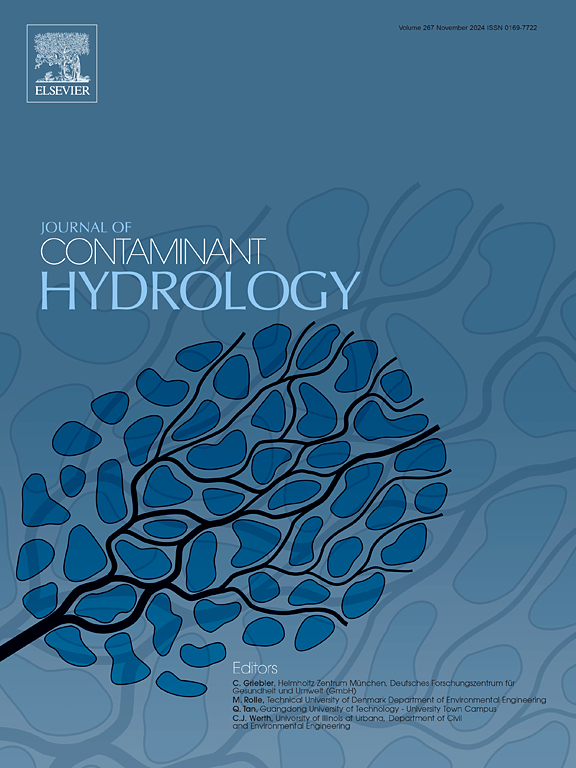Freeze-thaw effect on adsorption and transport of two sulfonamides in soil: Batch and column studies
IF 3.5
3区 环境科学与生态学
Q2 ENVIRONMENTAL SCIENCES
引用次数: 0
Abstract
Freeze-thaw cycles (FTCs) have significant impacts on soil physicochemical properties, subsequently altering the fate of contaminants in soil. However, studies investigating the environmental behavior of antibiotics in soil subjected to FTCs are limited. This study investigated the effects of FTCs on the adsorption and transport of two commonly used sulfonamide antibiotics (SAs), sulfamethoxazole (SMX) and sulfapyridine (SPY), in soil. The results revealed that FTCs alter the adsorption behavior of SMX and SPY on the soil. Initially, after 1 FTC, the adsorption of both SMX and SPY decreased; however, subsequently, this adsorption gradually increased as the number of FTCs increased. This is because, during the FTCs, the increased soil pH hindered the adsorption of SAs by intensifying electrostatic repulsion between anionic SAs and soil particles. Subsequently, the increases in clay content, specific surface area (SA), small pores, and dissolved organic matter (DOM) provided more adsorption sites, overriding the initial pH effects and ultimately dominating the adsorption process. FTCs altered soil properties, which not only changed the adsorption of SAs but also induced the alteration of pore structure and the generation of preferential flow. During the vertical transport process, such changes in pore pathways played a dominant role, facilitating SMX and SPY transport in soil. The addition of heavy metals (Cd2+ and Cu2+) contributed to facilitating the transport of SMX and SPY in both unfrozen and freeze-thaw-treated soil columns. In the context of global climate change, this study offers valuable insights into the fate and environmental risks associated with pollutants in soil.

冻融对土壤中两种磺胺类物质吸附和迁移的影响:批和柱研究
冻融循环对土壤的理化性质有重要影响,从而改变了土壤中污染物的命运。然而,研究抗生素在FTCs作用下土壤中的环境行为是有限的。本研究考察了氟氯化碳对两种常用磺胺类抗生素磺胺甲恶唑(SMX)和磺胺吡啶(SPY)在土壤中的吸附和转运的影响。结果表明,FTCs改变了SMX和SPY在土壤上的吸附行为。最初,在1 FTC后,SMX和SPY的吸附量均下降;然而,随后,随着FTCs数量的增加,这种吸附逐渐增加。这是因为,在FTCs过程中,土壤pH值的增加通过增强阴离子sa与土壤颗粒之间的静电斥力来阻碍sa的吸附。随后,粘土含量、比表面积(SA)、小孔隙和溶解有机质(DOM)的增加提供了更多的吸附位点,覆盖了初始pH效应,最终主导了吸附过程。FTCs改变了土壤的性质,不仅改变了对SAs的吸附,还引起了孔隙结构的改变和优先流的产生。在垂直运移过程中,这种孔隙途径的变化起主导作用,有利于SMX和SPY在土壤中的运移。重金属(Cd2+和Cu2+)的加入促进了未冻和冻融土柱中SMX和SPY的迁移。在全球气候变化的背景下,本研究为土壤中污染物的命运和环境风险提供了有价值的见解。
本文章由计算机程序翻译,如有差异,请以英文原文为准。
求助全文
约1分钟内获得全文
求助全文
来源期刊

Journal of contaminant hydrology
环境科学-地球科学综合
CiteScore
6.80
自引率
2.80%
发文量
129
审稿时长
68 days
期刊介绍:
The Journal of Contaminant Hydrology is an international journal publishing scientific articles pertaining to the contamination of subsurface water resources. Emphasis is placed on investigations of the physical, chemical, and biological processes influencing the behavior and fate of organic and inorganic contaminants in the unsaturated (vadose) and saturated (groundwater) zones, as well as at groundwater-surface water interfaces. The ecological impacts of contaminants transported both from and to aquifers are of interest. Articles on contamination of surface water only, without a link to groundwater, are out of the scope. Broad latitude is allowed in identifying contaminants of interest, and include legacy and emerging pollutants, nutrients, nanoparticles, pathogenic microorganisms (e.g., bacteria, viruses, protozoa), microplastics, and various constituents associated with energy production (e.g., methane, carbon dioxide, hydrogen sulfide).
The journal''s scope embraces a wide range of topics including: experimental investigations of contaminant sorption, diffusion, transformation, volatilization and transport in the surface and subsurface; characterization of soil and aquifer properties only as they influence contaminant behavior; development and testing of mathematical models of contaminant behaviour; innovative techniques for restoration of contaminated sites; development of new tools or techniques for monitoring the extent of soil and groundwater contamination; transformation of contaminants in the hyporheic zone; effects of contaminants traversing the hyporheic zone on surface water and groundwater ecosystems; subsurface carbon sequestration and/or turnover; and migration of fluids associated with energy production into groundwater.
文献相关原料
公司名称
产品信息
阿拉丁
SMX
 求助内容:
求助内容: 应助结果提醒方式:
应助结果提醒方式:


